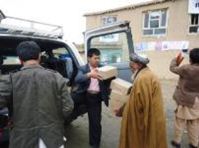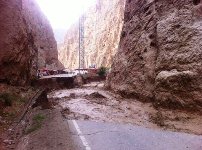 Supplies delivered to flood-affected areas in AfghanistanKabul,12 May 2014 – Heavy rainfall since 24 April has resulted in flash floods in northern Afghanistan where 675 people have lost their lives and more than 16 000 people remain displaced. Recently, three more provinces have experienced flooding, bringing the number of people affected to 120 000. The floods have washed away houses and roads, and destroyed crops and livestock in 88 districts across 16 provinces. More floods are expected.
Supplies delivered to flood-affected areas in AfghanistanKabul,12 May 2014 – Heavy rainfall since 24 April has resulted in flash floods in northern Afghanistan where 675 people have lost their lives and more than 16 000 people remain displaced. Recently, three more provinces have experienced flooding, bringing the number of people affected to 120 000. The floods have washed away houses and roads, and destroyed crops and livestock in 88 districts across 16 provinces. More floods are expected.
WHO, as Health Sector Cluster lead agency, continues to provide much-needed assistance to flood-affected areas in close coordination with government disaster management structures at national and provincial levels, other UN agencies and nongovernmental organizations.
Provision of emergency relief is challenging due to security threats and poor road conditions in some provinces and the sheer magnitude of the devastation. Coordination of information gathering between different agencies is hindered by the scope of the humanitarian crisis and the high number of people affected.
“Despite challenges, on the ground all partners stood up to their responsibility, all agencies were ready to provide support and relief on the spot when the disaster hit,” says Dr Iman Shankiti, Health Cluster and Emergency Coordinator at WHO Afghanistan. “WHO and other partners are continuously gathering information, assessing needs and identifying gaps in emergency response to ensure relief is effective and responds to real needs.”
 Major destruction on the Mazar-Kabul highway will obstruct supply delivery to affected areasOn 7 May, WHO, UNICEF and the Ministry of Rural Rehabilitation and Development, conducted a joint field visit to oversee and monitor the implementation of emergency response activities in Jawjzan province. Several data collection techniques were used to get an accurate overview of the situation, including desk review, health walks in internally displaced persons (IDP) sites, water testing and key-informant interviews with community leaders and women living in IDP camps.
Major destruction on the Mazar-Kabul highway will obstruct supply delivery to affected areasOn 7 May, WHO, UNICEF and the Ministry of Rural Rehabilitation and Development, conducted a joint field visit to oversee and monitor the implementation of emergency response activities in Jawjzan province. Several data collection techniques were used to get an accurate overview of the situation, including desk review, health walks in internally displaced persons (IDP) sites, water testing and key-informant interviews with community leaders and women living in IDP camps.
The most common diseases people in flood-affected areas suffer from are skin diseases, worm infections and respiratory infections. To date, there have been no reports of communicable disease outbreaks and there is no noticeable increase in diarrhoea, malaria or acute respiratory infections. WHO and partners have successfully addressed the health needs in the affected areas: mobile health teams are active in all areas and adequate stocks of drugs and other supplies have been delivered.
In coordination with its partners, WHO will continue to deliver services to people suffering from the devastation caused by the floods. A measles campaign is set to kick off in all areas affected by floods to vaccinate children between nine months and 10 years. Psychosocial first aid teams will travel to affected areas to provide specific counselling to women and children. Additional drugs and supplies are being sent to the region, while more supplies are being purchased.
 WHO technical staff testing chlorination of water with people affected by floods in Jawjzan province“There is a need to address remaining gaps in IDP sites, including washing facilities, hygiene promotion and emergency latrines,” says Dr Rik Peeperkorn, WHO Representative in Afghanistan. “WHO will continue its coordinated efforts in these affected areas to help people recover from the destruction and rebuild their lives.”
WHO technical staff testing chlorination of water with people affected by floods in Jawjzan province“There is a need to address remaining gaps in IDP sites, including washing facilities, hygiene promotion and emergency latrines,” says Dr Rik Peeperkorn, WHO Representative in Afghanistan. “WHO will continue its coordinated efforts in these affected areas to help people recover from the destruction and rebuild their lives.”


